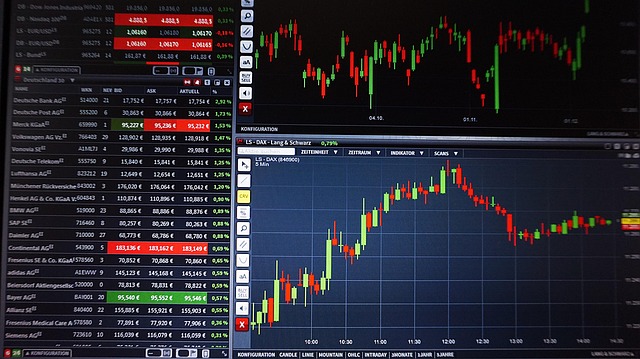Are Forex Signals Worth It? A Practical Guide for Traders
Author: Jameson Richman Expert
Published On: 2025-11-07
Prepared by Jameson Richman and our team of experts with over a decade of experience in cryptocurrency and digital asset analysis. Learn more about us.
Are forex signals worth it is a question many new and experienced traders ask when they see promises of easy profits and high win rates. This article summarizes how forex signals work, the pros and cons of using them, how to evaluate signal providers, and practical steps to get measurable value from signals — including examples, metrics to track, and recommended workflows to protect capital. Whether you’re considering free Telegram alerts or a paid professional service, this guide will help you decide if signals are a useful part of your trading toolkit.

What Are Forex Signals?
Forex signals are trade ideas or instructions indicating when to enter and exit a currency trade. A typical signal includes:
- Currency pair (e.g., EUR/USD)
- Action (buy/sell)
- Entry level (price or price range)
- Stop loss (risk management)
- Take profit (target)
- Timeframe (e.g., M15, H4, daily)
Signals can be generated manually by experienced analysts or automatically by algorithms, indicators, or AI systems. They are delivered through channels like Telegram, email, SMS, trading platforms (e.g., TradingView), or APIs to copy-trading platforms.
Types of Forex Signals
- Manual analyst signals — human traders or analysts publish setups based on technical and/or fundamental analysis.
- Automated algorithmic signals — systems use indicators, pattern recognition, or rule-based logic to issue signals.
- AI- and machine-learning signals — advanced models that learn from large datasets; often used in crypto and forex — see an example of AI trading bot discussion in this practical guide on AI crypto bots.
- Copy-trading/social signals — follow live trades from experienced traders (often on platforms that support mirroring).
- Hybrid approaches — combine human oversight with algorithmic generation.
Why Traders Use Forex Signals
Traders choose signals for several reasons:
- Save time — outsource market scanning and idea generation.
- Learn faster — observe how experienced traders set entries, stops, and targets.
- Diversify strategies — add more setups and timeframes to your portfolio.
- Automation — connect signals to execution systems for hands-off trading.
- Confidence — use signals as a second opinion for trade decisions.

Are Forex Signals Worth It? Pros and Cons
Pros
- Time efficiency: Signals reduce the time required for analysis and trade scanning.
- Access to expertise: Retail traders can benefit from institutional-style research.
- Scalability: Signal-driven approaches can be scaled across multiple accounts and markets.
- Education: Good signal services explain reasoning, which accelerates learning.
- Automation-ready: Signals can feed copy-trading or execution bots.
Cons
- Quality variance: Many providers overstate performance; signals range widely in quality.
- No guaranteed profits: Even high-accuracy signals lose sometimes; drawdowns occur.
- Over-reliance: Blindly following signals without understanding can be risky.
- Latency and slippage: Execution delays and slippage can turn winning signals into losses.
- Cost: Paid services, if poor, can erode returns.
How to Judge Whether Signals Are Worth It for You
Deciding whether signals are worth it depends on clear criteria. Evaluate any signal service along these dimensions:
1. Transparency
Does the provider publish verified performance or a third-party audited track record? Look for detailed logs showing entry/exit timestamps, slippage, fees, and drawdown. Beware of screenshots or selective reporting. A legitimate service will show both winners and losers.
2. Verified Performance Metrics
Key metrics include:
- Win rate — percentage of profitable trades.
- Average risk-reward ratio — how much you stand to gain relative to risked capital.
- Profit factor — gross profit divided by gross loss.
- Maximum drawdown — largest peak-to-trough decline.
- Expectancy — average return per trade.
A high win rate with poor risk-reward is not automatically good. For example, 70% wins with a 0.5:1 reward-to-risk can still lose money over time. Look for balanced metrics.
3. Delivery Method and Latency
How are signals delivered? Telegram and email are common, but they introduce latency. API or platform-native signals (e.g., TradingView alerts) often allow faster execution. Learn more about whether TradingView acts as a broker and how to execute alerts in this clear explanation.
4. Risk Management Rules
A trustworthy provider includes stop-loss guidance, position-sizing recommendations (e.g., fractional risk), and maximum open trades to control exposure.
5. Historical Context and Strategy Rationale
Good providers explain the market context and why a trade was taken. This helps you learn and evaluate if the strategy fits your temperament and time horizon. You can also glean lessons from trading competitions — for example, the strategy lessons revealed by winners in academic competitions can provide real-world insights into robust approaches.
6. Support, Education, and Refunds
Check for customer support, educational resources, and clear refund policies. Free trials or money-back guarantees reduce your upfront risk.
Common Red Flags
- Guaranteed returns or claims of 100% accuracy.
- Vague descriptions of methodology.
- No verifiable performance history or independently audited results.
- Aggressive upselling or pressure to upgrade.
- Lack of risk management rules or unrealistic leverage suggestions.

How to Evaluate a Signal Service — Step-by-Step
- Start with a demo account: Mirror signals in a demo or paper account for at least 100 trades or 3 months to collect statistically meaningful data.
- Track performance rigorously: Log entries, exits, slippage, fees, and position sizes. Use this to compute expectancy, profit factor, and drawdown.
- Assess risk per trade: Avoid services that recommend risking large portions of equity per trade.
- Test across market conditions: Check how signals performed in trending and choppy markets.
- Start small with real capital: If demo results look good, allocate a small live amount and scale up gradually.
- Use position sizing: Control risk using fixed fractional or Kelly-derived sizing rules.
Examples: Interpreting Signal Performance
Example A: Provider A shows a 60% win rate, average reward-to-risk 1.8:1, and profit factor 1.6 with max drawdown 8%. Expectancy might be positive — this is promising if verified.
Example B: Provider B advertises a 90% win rate but with 0.3:1 reward-to-risk and unverified trades. This high win rate may hide small winners and occasional large losses — risky.
Signal Delivery Options and Execution
How you receive and execute signals affects results:
- Telegram/Email/SMS — easy but variable latency; manual execution may incur slippage.
- Platform alerts (TradingView) — can send webhook alerts to execution systems. See an explanation of whether TradingView is a broker and how alerts work for clearer execution options.
- API/Automated bridging — fastest and most reliable for algorithmic execution; requires technical setup.
- Copy-trading platforms — trade mirroring providers execute trades automatically for followers, reducing human execution error.

Automation, Bots, and AI — Are They Better?
Automated systems can execute signals with low latency and strict risk rules. AI-driven models are increasingly used, especially in crypto, but require careful validation. Read practical picks, setup guidance, and safety tips for AI trading bots to understand their limits before using them in live trading.
Costs and ROI: How Much Should You Pay?
Costs vary from free to several hundred dollars per month. Factor in:
- Subscription fees
- Slippage and spreads
- Commissions
- Time saved and educational value
As a rule of thumb, a signal service is worth its cost if it increases your risk-adjusted returns (e.g., Sharpe ratio, CAGR after fees) compared to your baseline performance. Always test with a demo account and measure the incremental improvement.
Real-World Use Cases
1. Time-Constrained Professionals
Traders with limited time can use signals for trade ideas and apply conservative position sizing. Signals reduce research time but should be combined with basic checks.
2. Novice Traders Seeking Education
Beginners can learn from well-documented signals that explain the rationale. However, education-only signals are preferable to opaque “copy this” services.
3. Algorithmic Traders
Quant traders may use signals as inputs to larger models or to diversify strategies. Automation and API access are key here.
4. Crypto & Forex Crossover
Many signal providers cover both forex and crypto markets. If you trade across asset classes, ensure you understand differences in volatility and liquidity. For context on strategy lessons and live competition strategies, read this summary of academic trading competitions and their lessons.

Practical Workflow to Use Signals Safely
- Choose 2–3 signal providers and run them in parallel on demo accounts.
- Log every trade and compute metrics weekly and monthly.
- Only risk a small percentage of equity per trade (e.g., 0.5–1%).
- Use stop loss and avoid changing it impulsively.
- Limit the number of simultaneous open signals to control correlation risk.
- Re-evaluate providers quarterly and drop underperformers.
Frequently Asked Questions
Do paid signals outperform free signals?
Not always. Some paid services offer better vetting and support, but free channels can be high-quality too. The key is verified performance and disciplined risk management, not price alone.
Can I automate signals to avoid slippage?
Yes. Webhooks, APIs, and copy-trade bridges reduce latency and human error. However, automation requires careful testing and monitoring (fail-safes, maximum slippage tolerances).
How many signals should I follow per day?
Quality over quantity. Depending on your capital and risk rules, 1–5 well-sized signals per day or week may outperform dozens of low-probability alerts.
Are crypto signals the same as forex signals?
Conceptually similar, but crypto tends to be more volatile and 24/7, requiring different risk management (larger stop sizes, adjusted leverage). If you trade both, adapt sizing and execution rules accordingly. For AI and bot-based crypto trade automation insights, see this practical AI crypto trading bot guide.
Regulation, Compliance, and Safety
Signal providers are not always regulated. If a provider offers managed accounts or investment-like services, ensure proper licensing. Always treat signals as educational or trading guidance unless you have a formal asset management contract with a regulated entity. For general background on the foreign exchange market, see the authoritative overview on Wikipedia.

Recommended Platforms to Execute Signals
While forex is typically traded via forex brokers, many traders also use crypto exchanges for FX-like pairs or crypto signals. Below are reputable platforms you can consider for executing signals; each supports different instruments and features for automation and copy trading:
- Binance (register) — wide instrument coverage, APIs, and copy-trade options.
- MEXC (register) — competitive fees and API access.
- Bitget (register) — copy-trade friendly and supported integrations.
- Bybit (register) — strong API and derivatives support.
Note: If you trade classic forex (major and minor currency pairs), choose a regulated forex broker in your jurisdiction. For platform-specific guidance on alerts and execution, see the article on whether TradingView functions as a broker.
Case Study: A Realistic Test Plan
Suppose you’re evaluating a paid signal service charging $150/month. Set up the following test:
- Run signals in a demo account for 3 months or until 100 trades.
- Log P&L, average slippage, win rate, reward-to-risk, max drawdown, and profit factor.
- Compute net profit per month net of hypothetical fees and compare to subscription cost.
- If the service yields positive expectancy and covers the subscription at your trade size (e.g., net monthly edge > $150 for your position sizing), it may be worth it.
This objective, numbers-driven approach reduces emotional bias and gives you a clear ROI metric.
Alternatives to Buying Signals
- Learn technical analysis — self-sufficiency avoids subscription costs.
- Join educational programs — structured trading courses may offer better long-term value.
- Use free screeners — platforms like TradingView provide powerful screeners to generate your own ideas.
- Copy-trading with transparent performance — pick traders with verifiable public track records.

Final Verdict: Are Forex Signals Worth It?
Short answer: They can be — but only when used correctly. Forex signals are tools, not miracles. They are worth the cost for traders who:
- Vet providers with verified performance and transparency.
- Use disciplined risk management and position sizing.
- Test on demo accounts before scaling with real capital.
- Prefer signals as part of a broader strategy (education + signals + risk controls).
Signals are less useful for traders who rely on them blindly, ignore costs and slippage, or pick providers based on marketing alone. If you aim for consistent, measured improvement — use signals as inputs, not the whole plan.
Further Reading and Resources
- Foreign exchange market — Wikipedia (background on FX markets)
- Forex signal — Investopedia (definition and common concepts)
- Inside UChicago Trading Competition — lessons and strategies (strategy insights from competition winners)
- Is TradingView a broker? — clear explanation (alerts and execution context)
- Best AI crypto trading bot for beginners — picks and safety tips (automation and safety lessons)
Actionable Next Steps
- Identify 2–3 signal providers and run them in demo for at least 3 months.
- Create a simple trade log template (entry, exit, size, slippage, P&L).
- Measure expectancy and profit factor; compare net gain vs subscription costs.
- If satisfied, start small in live accounts and scale with strict risk rules.
- Review performance quarterly and drop services that fail to meet objective metrics.
Using these steps will help you determine whether forex signals are worth it for your unique situation. Remember: signals are a supplement to disciplined trading — not a substitute for it.